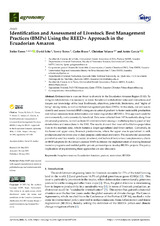Identification and Assessment of Livestock Best Management Practices (BMPs) Using the REED+ Approach in the Ecuadorian Amazon
Autor
Torres, Bolier
Eche, David
Torres, Yenny
Bravo, Carlos
Velasco, Christian
García, Antón
Editor
MDPIFecha
2021Materia
Biosphere reserveEcuadorian Amazon
Pasture
Restoration
REDD+
METS:
Mostrar el registro METSPREMIS:
Mostrar el registro PREMISMetadatos
Mostrar el registro completo del ítemResumen
Deforestation is a severe threat to diversity in the Ecuadorian Amazon Region (EAR). To mitigate deforestation, it is necessary to know the relevant stakeholders’ roles and interactions and deepen our knowledge of the local livelihoods, objectives, potentials, limitations, and “rights of being” among farms, as well as the best management practices (BMPs). In this study, our aim was to identify and assess livestock BMPs along an elevational gradient to foster sustainable production and reduce emissions from deforestation and forest degradation (REDD+). This approach could be environmentally and economically beneficial. Data were collected from 167 households along three elevational gradients, as well as from 15 interviews held among a multidisciplinary panel of key stakeholders and researchers in the EAR. The results showed that most of the Kichwa population lives in the medium zone, which features a larger agricultural and forest surface. Conversely, in the lower and upper areas, livestock predominates, where the upper area is specialized in milk production and the lower area in dual-purpose cattle (meat and dairy). The stakeholder assessment provided several key results: (a) social, structural, and technical factors have complementary effects on BMP adoption; (b) the sixteen assessed BMPs facilitated the implementation of existing financial incentive programs and enabled public–private partnerships to develop REDD+ projects. The policy implications of implementing these approaches are also discussed.

